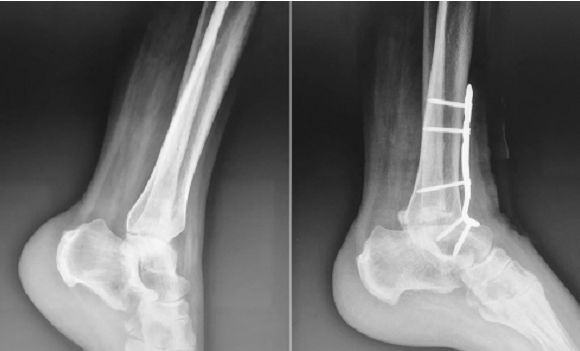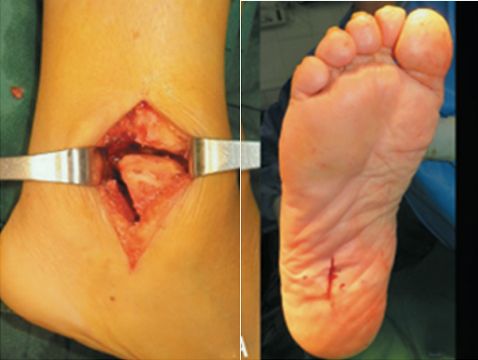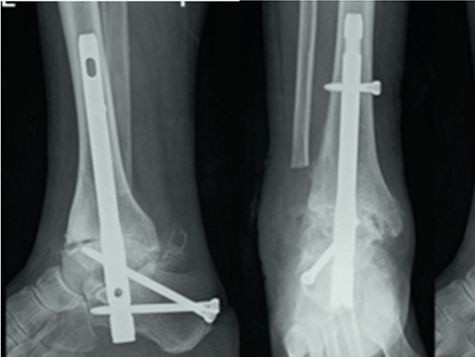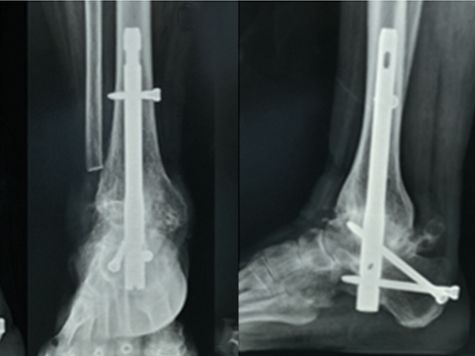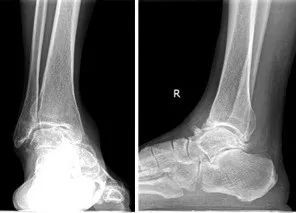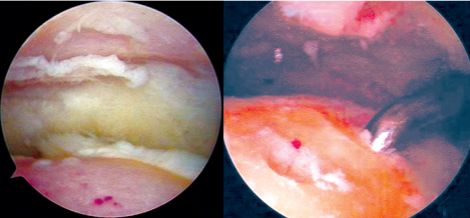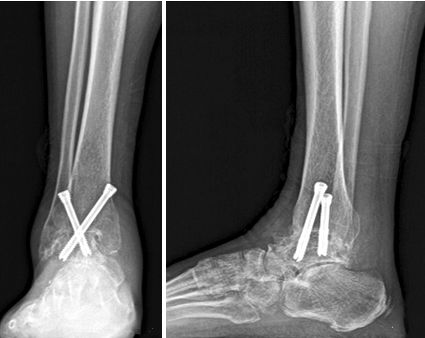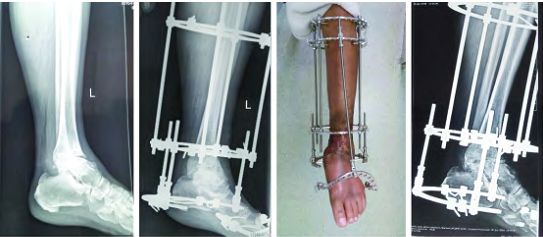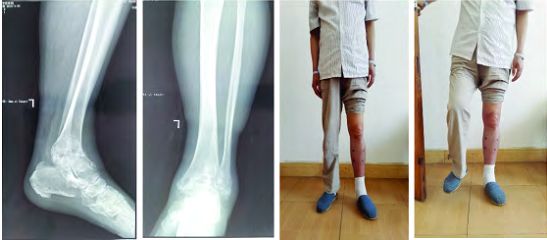Suidheachadh a-staigh le plàta cnàimh
Tha co-aonadh adhbrannan le pleitean is sgriothan na dhòigh-obrach lannsaichte gu math cumanta an-dràsta. Tha daingneachadh a-staigh pleit glasaidh air a chleachdadh gu farsaing ann an co-aonadh adhbrannan. An-dràsta, tha co-aonadh adhbrannan pleit a’ toirt a-steach co-aonadh adhbrannan pleit aghaidh is pleit taobhach sa mhòr-chuid.
Tha an dealbh gu h-àrd a’ sealltainn na filmichean X-ghath ro agus às dèidh lannsaireachd airson osteoarthritis traumatach an adhbrann le plàta glasaidh aghaidh daingneachadh a-staigh co-aonadh an adhbrann
1. Dòigh-obrach roimhe
Is e an dòigh-obrach aghaidh gearradh fadail aghaidh a dhèanamh ann am meadhan àite co-alt na h-adhbrann, gearradh sreath air shreath, agus a dhol a-steach air feadh àite nan teannan; gearradh capsal a’ cho-alt, nochd an t-alt tibiotalar, thoir air falbh an cartilage agus a’ chnàimh fo-chondral, agus cuir a’ phlàta aghaidh air aghaidh na h-adhbrann.
2. Dòigh-obrach taobhach
Is e an dòigh-obrach taobhach an osteotomy a ghearradh mu 10 cm os cionn bàrr na fibula agus an stump a thoirt air falbh gu tur. Thèid stump a’ chnàimh cancellous a thoirt a-mach airson grafadh cnàimh. Thèid an osteotomy uachdar co-aonaichte a chrìochnachadh agus a nighe, agus thèid am plàta a chuir air taobh a-muigh co-alt na h-adhbrann.
Is e a’ bhuannachd gu bheil neart an daingneachaidh àrd agus gu bheil an daingneachadh daingeann. Faodar a chleachdadh airson càradh is ath-thogail deformachadh varus no valgus dona co-alt na h-adhbrann agus mòran lochdan cnàimh às dèidh glanadh. Bidh am plàta co-aonaidh a chaidh a dhealbhadh gu anatomically a’ cuideachadh le bhith ag ath-nuadhachadh anatomy àbhaisteach co-alt na h-adhbrann. Suidheachadh.
Is e an ana-cothrom gu bheil feum air barrachd den periosteum agus clò bog san raon lannsaireachd a thoirt air falbh, agus tha am plàta stàilinn nas tiugh, agus mar sin tha e furasta na teannanan mun cuairt a ghoirteachadh. Tha am plàta stàilinn a tha air a chur air a bheulaibh furasta a bhualadh fon chraiceann, agus tha cunnart sònraichte ann.
daingneachadh ìnean intramedullary
Anns na bliadhnachan mu dheireadh, tha cleachdadh arthrodesis cùl-ingne intramedullary retrograde ann an làimhseachadh airtritis cùl-ingne air a bhith air a chur an sàs gu clionaigeach mean air mhean.
An-dràsta, bidh an dòigh-obrach airson tairngean intramedullary a’ cleachdadh gearradh meadhanach anterior de cho-alt na h-adhbrann no gearradh taobhach anteroinferior den fibula airson glanadh uachdar articular no grafadh cnàimh. Tha an tairngean intramedullary air a chuir a-steach bhon calcaneus chun chuas medullary tibial, rud a tha buannachdail airson ceartachadh deformity agus a’ brosnachadh aonadh cnàimh.
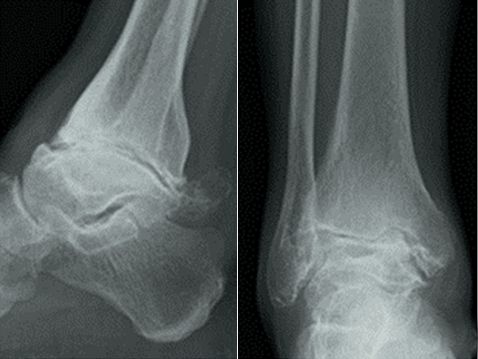
Osteoarthritis na h-adhbrann còmhla ri airtritis fo-thalar. Sheall filmichean X-ghath anteroposterior agus lateral ro-obrachaidh milleadh mòr air an alt tibiotalar agus an alt fo-thalar, tuiteam pàirteach den talus, agus cruthachadh osteophyte timcheall air an alt (bho iomradh 2)
Tha ceàrn implantachaidh sgriubha co-aonaidh diofraichte ingne intramedullary co-aonaidh deiridh na dhaingneachadh ioma-phlèana, a dh’ fhaodas an co-alt sònraichte a tha ri cheangal a dhaingneachadh, agus tha toll glasaidh snàthaichte aig a’ cheann distal, a dh’ fhaodas seasamh an aghaidh gearradh, rothladh agus tarraing a-mach gu h-èifeachdach, a’ lughdachadh cunnart tarraing air ais sgriubha.
Chaidh an co-alt tibiotalar agus an co-alt subtalar fhoillseachadh agus a phròiseasadh tron dòigh-obrach transfibular lateral, agus b’ e 3 cm fad an ghearraidh aig beul na h-ingne intramedullary plantar.
Tha an t-ingne intramedullary air a chleachdadh mar cheangal meadhanach, agus tha an cuideam aige air a sgaoileadh gu ìre mhath, agus faodaidh seo buaidh dìon cuideam a sheachnadh agus tha e nas co-chòrdail ri prionnsapalan bith-mheacanaig.
Sheall film X-ghath anteroposterior agus lateral mìos an dèidh an obrachaidh gu robh loidhne cùil na coise math agus gun deach an t-ingne intramedullary a dhaingneachadh gu earbsach.
Faodaidh cur tairngean intramedullary retrograde ri co-leaghadh co-alt na h-adhbrann milleadh a dhèanamh air clò bog, necrosis craiceann an ghearraidh, galair agus duilgheadasan eile a lughdachadh, agus faodaidh e daingneachadh seasmhach gu leòr a thoirt seachad gun daingneachadh taobh a-muigh plastair cuideachail às dèidh lannsaireachd.
Bliadhna an dèidh na h-obrachaidh, sheall na filmichean X-ghath adhartach is taobhach a bha a’ giùlan cuideam co-aonadh cnàimheach an alt tibiotalar agus an alt subtalar, agus bha co-thaobhadh cùil na coise math.
Faodaidh an t-euslainteach èirigh às an leabaidh agus cuideam a ghiùlan tràth, a leasaicheas fulangas agus càileachd beatha an euslaintich. Ach, leis gu bheil feum air an alt fo-thalamh a chàradh aig an aon àm, chan eilear ga mholadh do dh’euslaintich le alt fo-thalamh math. Tha gleidheadh an alt fo-thalamh na structar cudromach airson dìoladh a dhèanamh airson gnìomh an alt adhbrann ann an euslaintich le co-aonadh alt adhbrann.
daingneachadh a-staigh sgriubha
'S e dòigh chumanta a th' ann an daingneachadh a-staigh le sgriubha percutaneous ann an arthrodesis an adhbrann. Tha buannachdan ann a thaobh lannsaireachd le glè bheag de ionnsaigh, leithid gearradh beag agus nas lugha de chall fala, agus faodaidh e milleadh air clò bog a lughdachadh gu h-èifeachdach.
Sheall filmichean X-ghath anteroposterior agus lateral den alt adhbrann seasamh ron obair-lannsa osteoarthritis dona den adhbrann deas le deformity varus, agus chaidh an ceàrn eadar uachdar articular tibiotalar a thomhas mar 19° varus.
Tha sgrùdaidhean air sealltainn gum faod daingneachadh sìmplidh le 2 gu 4 sgriothan lag daingneachadh agus teannachadh seasmhach a choileanadh, agus gu bheil an obair-lannsa an ìre mhath sìmplidh agus gu bheil a’ chosgais an ìre mhath saor. Is e seo a’ chiad roghainn aig a’ mhòr-chuid de sgoilearan an-dràsta. A bharrachd air an sin, faodar glanadh co-phàirteach an adhbrann le glè bheag de ionnsaigh a dhèanamh fo arthroscopy, agus faodar sgriothan a chuir a-steach tron chraiceann. Tha an dochann lannsaireachd beag agus tha a’ bhuaidh leigheis riarachail.
Fo artroscopaidh, chithear raon mòr de locht cartilage articular; fo artroscopaidh, thathar a’ cleachdadh an inneal microfracture còn biorach gus an uachdar articular a làimhseachadh.
Tha cuid de ùghdaran den bheachd gum faod daingneachadh 3 sgriubha lùghdachadh a dhèanamh air cunnart neo-aonadh às dèidh obair-lannsa, agus gum faodadh an àrdachadh ann an ìre aonaidh a bhith co-cheangailte ri seasmhachd nas làidire daingneachadh 3 sgriubha.
Sheall film-X leanmhainn 15 seachdainean an dèidh an obrachaidh co-aonadh cnàimh. Bha sgòr AOFAS 47 puingean ron lannsaireachd agus 74 puingean bliadhna an dèidh an lannsaireachd.
Ma thèid trì sgriothan a chleachdadh airson daingneachadh, is e an suidheachadh daingneachaidh tuairmseach gu bheil a’ chiad dà sgriothan air an cur a-steach fa leth bho thaobhan anteromedial agus anterolateral den tibia, a’ dol tarsainn air an uachdar articular chun a’ chuirp talar, agus tha an treas sgriothan air a chuir a-steach bho thaobh posterior na tibia chun taobh medial den talus.
Modh daingneachaidh taobh a-muigh
B’ e luchd-càraidh taobh a-muigh a’ chiad innealan a chaidh a chleachdadh ann an arthrodesis adhbrann agus tha iad air leasachadh bho na 1950an chun fhrèam-fànais Ilizarov, Hoffman, Hybrid agus Taylor (TSF) a th’ ann an-diugh.
Leòn fosgailte air an adhbrann le galar airson 3 bliadhna, arthrodesis air an adhbrann 6 mìosan an dèidh smachd a chumail air a’ ghalar
Airson cuid de chùisean airtritis adhbrann iom-fhillte le galairean a-rithist, obrachaidhean a-rithist, droch shuidheachaidhean craicinn is clò bog ionadail, cruthachadh sgarfaichean, lochdan cnàimh, osteoporosis agus lotan gabhaltach ionadail, thathas a’ cleachdadh an inneal-daingneachaidh taobh a-muigh fàinne Ilizarov nas clionaigeach gus an co-alt adhbrann a cheangal ri chèile.
Tha an socraichear taobh a-muigh cumadh fàinne stèidhichte air a’ phlèana coronal agus am plèana sagittal, agus faodaidh e buaidh socrachaidh nas seasmhaiche a thoirt seachad. Anns a’ phròiseas giùlain luchdan tràth, cuiridh e cuideam air ceann a’ bhrisidh, brosnaichidh e cruthachadh callus, agus leasaichidh e an ìre co-aonaidh. Airson euslaintich le deformachadh mòr, faodaidh an socraichear taobh a-muigh an deformachadh a cheartachadh mean air mhean. Gu dearbh, bidh duilgheadasan ann le bhith a’ co-aonadh adhbrann socraichear taobh a-muigh leithid mì-ghoireasachd dha euslaintich a bhith gan caitheamh agus cunnart gabhaltachd tract snàthaid.
Cuir fios gu:
WhatsApp: +86 15682071283
Email:liuyaoyao@medtechcah.com
Àm puist: 08 Iuchar 2023





